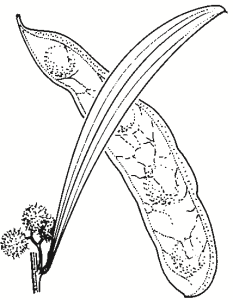Family:
Fabaceae
Acacia pendula
Boree
Other Names: Weeping Myall, Myall.

Name Origin:
pendula – From Latin pendulus, pendulous or hanging, referring to habit.
Regional Subspecies:
Occurrence:
Regional:
Mainly west of Olympic Highway on lower country and plains.
Australia:
Qld, NSW, Vic.
Habitat:
Major river floodplains, and the Riverine Plain, sometimes as dominant species on heavy clay soils. Often in large stands.
Habit:
Erect or spreading tree, 5-13 m high. Rounded grey-green crown of conspicuously drooping ‘leaves’ and branchlets. Fissured grey bark.
Site Preference:
Good soils — rich alluvial, clays or black soils with adequate ground water. Frost resistant.
Characteristics:
Relatively slow-growing. Relatively palatable to livestock. During drought trees lopped for fodder. Coppices, although very old trees damaged by lopping and may die. Prone to use by the Bag-shelter moth, which occasionally kills trees. Suitable for fire-prone areas.
Flowering:
Golden-yellow, mainly summer to autumn. Irregular, depending on season.
Seed Collection:
Early Oct to Jan.
Propagation:
From seed (6-28 viable seeds per gram). Immerse seeds in hot water at 90°C for about one minute, before drying and sowing.
Regeneration:
From seed if livestock fenced out. Coppices after fire.
VALUES:
Shade & Shelter:
Useful medium-level cover in windbreaks.
Land Protection:
Legume — improves soil fertility through ‘fixing’ nitrogen.
Wildlife:
Excellent habitat. Provides useful supplies of pollen. Often eaten by Procession caterpillars.
Seeds eaten by parrots.
Fuel:
Excellent. Was used extensively.
Timber:
Reasonable quality. Hard, heavy, dark and attractively marked, with violet-like fragrance. Used for fence posts and manufacturing trinket boxes and similar items.
First Nations:
Boomerangs made from wood.
Ornamental:
Very attractive ornamental, due to weeping grey foliage.
Other:
Valuable drought fodder.
